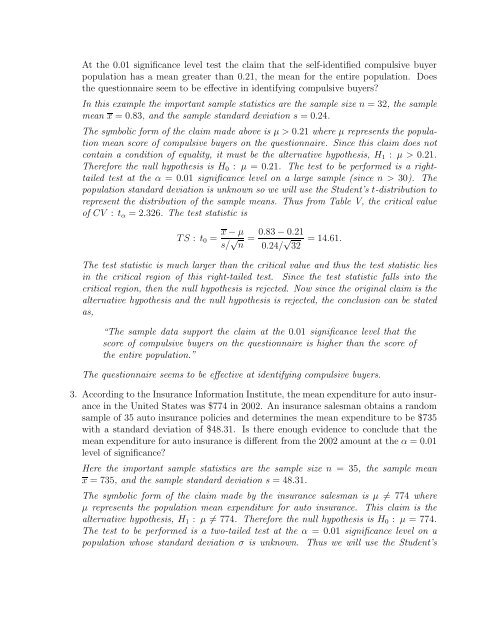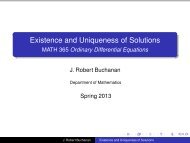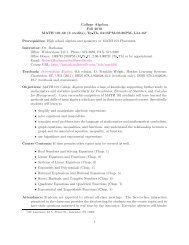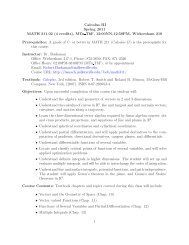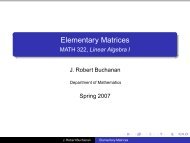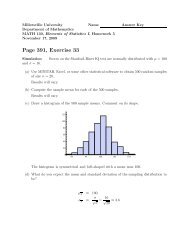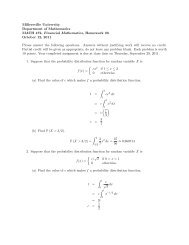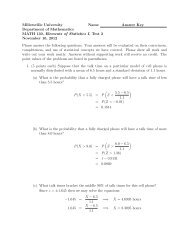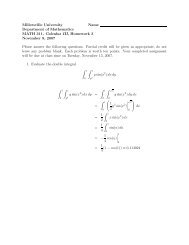Answers - Millersville University
Answers - Millersville University
Answers - Millersville University
You also want an ePaper? Increase the reach of your titles
YUMPU automatically turns print PDFs into web optimized ePapers that Google loves.
At the 0.01 significance level test the claim that the self-identified compulsive buyer<br />
population has a mean greater than 0.21, the mean for the entire population. Does<br />
the questionnaire seem to be effective in identifying compulsive buyers?<br />
In this example the important sample statistics are the sample size n = 32, the sample<br />
mean x = 0.83, and the sample standard deviation s = 0.24.<br />
The symbolic form of the claim made above is µ > 0.21 where µ represents the population<br />
mean score of compulsive buyers on the questionnaire. Since this claim does not<br />
contain a condition of equality, it must be the alternative hypothesis, H1 : µ > 0.21.<br />
Therefore the null hypothesis is H0 : µ = 0.21. The test to be performed is a righttailed<br />
test at the α = 0.01 significance level on a large sample (since n > 30). The<br />
population standard deviation is unknown so we will use the Student’s t-distribution to<br />
represent the distribution of the sample means. Thus from Table V, the critical value<br />
of CV : tα = 2.326. The test statistic is<br />
TS : t0 =<br />
x − µ<br />
s/ √ n<br />
= 0.83 − 0.21<br />
0.24/ √ 32<br />
= 14.61.<br />
The test statistic is much larger than the critical value and thus the test statistic lies<br />
in the critical region of this right-tailed test. Since the test statistic falls into the<br />
critical region, then the null hypothesis is rejected. Now since the original claim is the<br />
alternative hypothesis and the null hypothesis is rejected, the conclusion can be stated<br />
as,<br />
“The sample data support the claim at the 0.01 significance level that the<br />
score of compulsive buyers on the questionnaire is higher than the score of<br />
the entire population.”<br />
The questionnaire seems to be effective at identifying compulsive buyers.<br />
3. According to the Insurance Information Institute, the mean expenditure for auto insurance<br />
in the United States was $774 in 2002. An insurance salesman obtains a random<br />
sample of 35 auto insurance policies and determines the mean expenditure to be $735<br />
with a standard deviation of $48.31. Is there enough evidence to conclude that the<br />
mean expenditure for auto insurance is different from the 2002 amount at the α = 0.01<br />
level of significance?<br />
Here the important sample statistics are the sample size n = 35, the sample mean<br />
x = 735, and the sample standard deviation s = 48.31.<br />
The symbolic form of the claim made by the insurance salesman is µ = 774 where<br />
µ represents the population mean expenditure for auto insurance. This claim is the<br />
alternative hypothesis, H1 : µ = 774. Therefore the null hypothesis is H0 : µ = 774.<br />
The test to be performed is a two-tailed test at the α = 0.01 significance level on a<br />
population whose standard deviation σ is unknown. Thus we will use the Student’s


